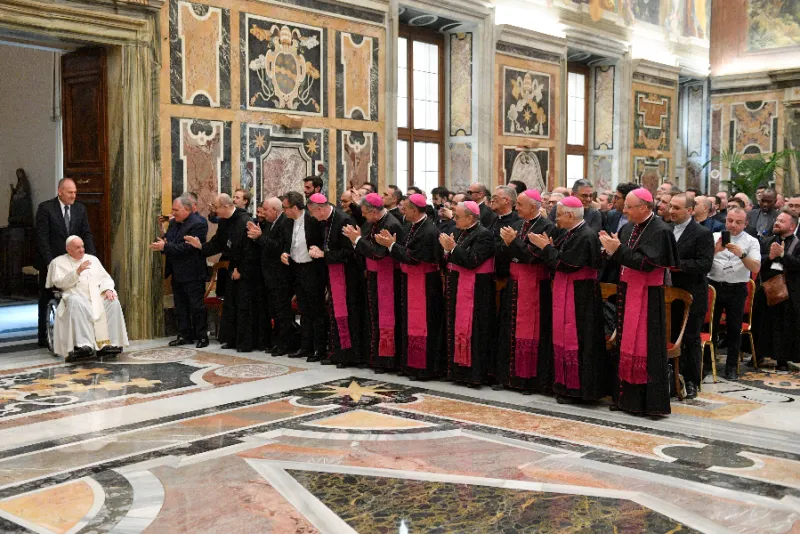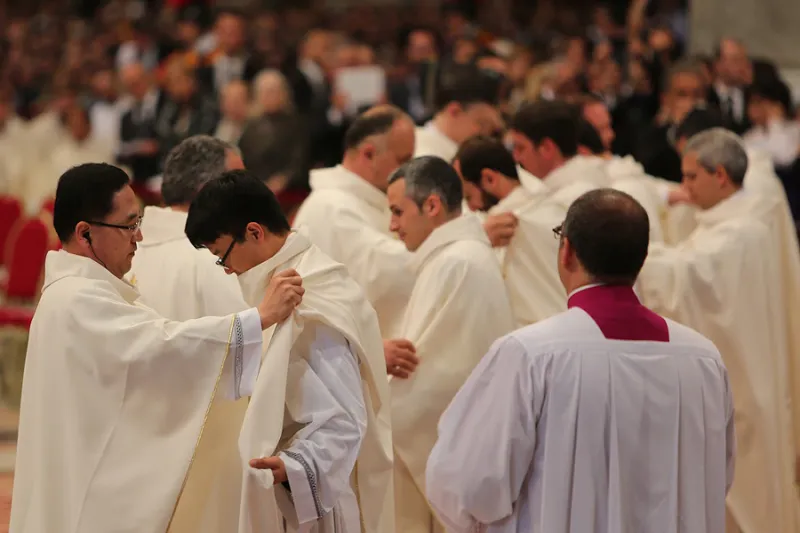
Pope Francis urges Sicily’s Catholic priests to be moral guides — but to drop the lace
 Pope Francis meets the bishops and priests of the churches of Sicily, Italy, in the Vatican’s Clementine Hall on June 9, 2022. / Vatican Media.
Pope Francis meets the bishops and priests of the churches of Sicily, Italy, in the Vatican’s Clementine Hall on June 9, 2022. / Vatican Media.
Vatican City, Jun 9, 2022 / 09:00 am (CNA).
Pope Francis told priests and bishops from the Italian island of Sicily on Thursday to be strong moral guides, and to update their art and vestments in conformity with Church reforms.
“In Sicily, people still look to priests as spiritual and moral guides, people who can also help to improve the civil and social life of the island, to support the family, and to be a reference for growing young people. High and demanding is the Sicilian people’s expectation of priests,” the pope said during a June 9 meeting at the Vatican.
In improvised comments during his speech, Francis also addressed a topic that he said “worries” him: the progress of the reforms of the Second Vatican Council, particularly relating to the liturgy.
“I don’t know, because I don’t go to Mass in Sicily and I don’t know how the Sicilian priests preach, whether they preach as was suggested in [the 2013 apostolic exhortation] Evangelii gaudium or whether they preach in such a way that people go out for a cigarette and then come back,” the pope said.
He suggested that after eight minutes of a homily, most people’s attention begins to wane.
Noting that he had seen photos from Masses in Sicily, Francis appeared also to comment on the use of lace on the vestments priests wear while celebrating Mass.
“Where are we 60 years after the Council,” he said. “Some updating even in liturgical art, in liturgical ‘fashion.’”
“Yes, sometimes bringing some of grandma’s lace is appropriate, sometimes. It’s to pay homage to grandma, right?” he continued. “It’s good to honor grandma, but it’s better to celebrate the mother, Holy Mother Church, and how Mother Church wants to be celebrated. So that insularity does not prevent the true liturgical reform that the Council sent out.”
Sicily, a southern Italian island region, has a population of 5 million people. The Catholic Church in the region is divided into 18 dioceses.
Around 300 of the island’s 2,078 priests, and 20 bishops, are in Rome for a pilgrimage and meeting with Pope Francis to mark the 30th anniversary of the Church in Sicily’s Regional Marian Priests’ Day.
Sicily, like the rest of Italy, is facing a decline in vocations to the priesthood, with 30% fewer seminarians compared with a decade ago.
In his speech in the Apostolic Palace, Pope Francis reflected on the changing times, including the decline in vocations.
The 85-year-old pope, who has made public appearances in a wheelchair since May 5 due to knee pain, said that priests and bishops needed to make courageous choices, with the discernment of the Holy Spirit, about how to share the Gospel of Christ today.
“We witness in Sicily behaviors and gestures marked by great virtues as well as cruel heinousness,” he said. “As well, alongside masterpieces of extraordinary artistic beauty we see scenes of mortifying neglect.”
He noted the declining social situation, including the fall in population due to a low birthrate and the exodus of young people looking for work.
“We need to understand how and in what direction Sicily is experiencing the change of age and what paths it could take, in order to proclaim, in the fractures and joints of this change, the Gospel of Christ,” he said.
“This task, while entrusted to the entire people of God, asks of us priests and bishops full, total, and exclusive service,” Pope Francis commented.
“Please, do not stand in the middle of the road,” he urged. “Faced with the awareness of our weaknesses, we know that the will of Christ places us in the heart of this challenge.”
“The key to everything is in his call,” he underlined, “on which we lean to take to the sea and cast our nets again. We do not even know ourselves, but if we return to the call, we cannot ignore that Face who has met us and drawn us behind Himself, even united us to himself, as our tradition teaches when it states that in the liturgy we even act ‘in persona Christi.’”
“This full unity, this identification, we cannot limit it to the celebration, but rather we must live it fully in every moment of life, mindful of the Apostle Paul’s words: ‘No longer do I live, but Christ lives in me,’” he said.


